Diplomatic Bluebook 2021
Chapter 2
Japan's Foreign Policy by Region
6 Oceania
(1) Australia
A Brief Summary and Overview
In the Foreign Policy White Paper issued by the Australian Government in November 2017, it was announced that as the guidelines for foreign policy of the next 10 years, Australia will, among others, promote an open, inclusive and prosperous Indo-Pacific region, oppose protectionism, promote and protect international rules, while also strengthening cooperation with partners including Japan. This foreign policy has continued to be upheld even after Prime Minister Scott Morrison replaced Prime Minister Malcolm Turnbull in August 2018.
With the region facing a variety of issues, the “Special Strategic Partnership” between Japan and Australia, which share fundamental values and strategic interests, is more important than ever. The two countries' strategic visions toward maintaining and strengthening a free and open international order based on the rule of law in the Indo-Pacific region are aligned in wide-ranging areas. With the Prime Ministers' annual mutual visits and close coordination between the Foreign Ministers serving as the basis, the two countries have been further deepening multi-layered cooperation and collaboration in all areas toward stability and prosperity of the international community. Furthermore, multilateral coordination and partnerships such as the Japan-U.S.-Australia, and Japan-U.S.-Australia-India relations are being steadily strengthened.
The two countries are promoting free trade, including the TPP Agreement. Australia is the fifth largest trading partner for Japan, and Japan is the second largest trading partner for Australia. The two countries are further developing mutually complementary economic relations based on the Japan-Australia Economic Partnership Agreement (EPA), which marks the sixth anniversary of its effectuation, and the TPP11 Agreement that entered into force at the end of 2018.
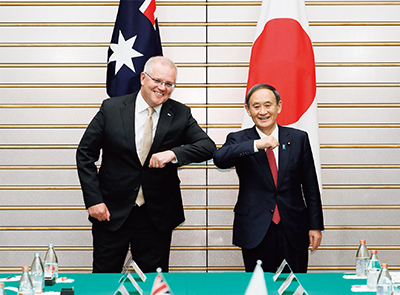 Japan-Australia Summit Meeting
Japan-Australia Summit Meeting(November 17, Tokyo; Photo: Cabinet Public Relations Office)
At the September Japan-Australia Summit telephone call with Prime Minister Morrison, which was the first telephone call with a foreign leader since the inauguration of Prime Minister Suga, Japan and Australia confirmed that, as “Special Strategic Partners,” both countries will further develop their complementary economic relationship, and, in anticipation of COVID-19 being brought to a close, confirmed that they would deepen cooperation for the realization of a “Free and Open Indo-Pacific” and for the stability and prosperity of the international community as a whole, and they also confirmed the importance of collaborating with like-minded countries in the region. Additionally, at the summit meeting held when Prime Minister Morrison visited Japan in November, which was the first visit of a foreign leader since the spread of COVID-19 and since the inauguration of Suga administration, the two leaders confirmed that the two countries had reached an agreement in principle on the “Japan-Australia Reciprocal Access Agreement,” which they had been negotiating to elevate security and defense cooperation between Japan and Australia to a new level. With regard to the economy, they confirmed that they will continue to collaborate on WTO reform including the reforms to the Appellate Body, rule-making on electronic commerce, and issues of “developing countries.” In addition to celebrating the signing of RCEP, they agreed to work closely and to play leading roles in Japan and Australia for RCEP's early entry into force, and the leaders also confirmed that they will continue to cooperate toward the steady implementation and expansion of the TPP11 Agreement.
As for between foreign ministers, Foreign Minister Motegi held a meeting with his Australian counterpart Marise Payne, who visited Japan for the Second Japan-Australia-India-U.S. Foreign Ministers' Meeting in October. With regard to security and defense cooperation, they affirmed the need not only to deepen their cooperation, but also to widen its scope in order to tackle contemporary new challenges. In regard to the economy, the Ministers discussed ways to resume travel between the two countries while maintaining preventive measures against the spread of COVID-19 as a way to develop economic relations between the two countries.
In a typical year, the forest fire season lasts from September until March in Australia. But the forest fire that broke out in the fall of 2019 was the most massive ever, keeping Prime Minister Morrison fully occupied with it. For its part, Japan deployed a Disaster Relief Team and Japan Self-Defense Force units between January 15 and February 8, 2020 and provided emergency assistance supplies (masks) (see the Special Feature on page 82).
1. Outbreak and damage of bushfires
The worst bushfires in history spread across the whole of Australia from September 2019. The fires, which continued to rage until March 2020, resulted in the loss of 33 lives and the destruction of more than 3,100 homes, among other damages that extended across more than 12 million hectares of land, larger than the whole of the Kanto and Koshinetsu region. This area of damage was 25 times that of the damage in the bushfires of 2009, which had been recognized as the worst in Australian history. The bushfires also resulted in many deaths among Australia's indigenous animal species that live in unique ecosystems, such as koalas. Direct damage alone is estimated to have reached close to 100 billion Australian dollars (approximately 7.6 trillion Japanese yen). Smoke from the bushfires also led to the closure of port facilities and construction sites, while the amount of private insurance claims associated with the bushfires has reached 1.9 billion Australian dollars. During this period, the number of foreign tourists fell by 10 to 20%, and the resulting loss of profits from tourism was estimated to be 4.5 billion Australian dollars.
2. Response by the Government of Australia
For the first time in history, the Government of Australia issued a compulsory call-up to 3,000 reservists from the Australian Defense Force to provide assistance in responding to the bushfires, while up to 6,500 personnel from the Australian Defense Force provided various forms of assistance in the areas of transportation, evacuation of residents, and the provision of relief supplies.
The National Bushfire Recovery Agency was established to manage at least 2 billion Australian dollars of funds over two years from 2020, with the aim of providing financial assistance to victims. In addition, a total of 60 million Australian dollars of assistance was disbursed to 42 municipalities that had suffered serious damage. The Government of Australia also decided to provide 76 million Australian dollars for the support of victims' mental health, 50 million Australian dollars for the support of industries in the affected regions, and 76 million Australian dollars for the support of the tourism industry.
A royal commission was also set up to evaluate the causes of the bushfires and the government response.
3. Support from Japan and other countries
To respond to these bushfires, Japan, as well as the U.S., Canada, New Zealand and other countries extended their assistance to Australia.
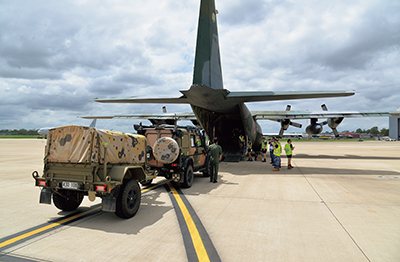 Transportation of Australian Defense Force vehicles by the SDF transport aircraft (Photo: Ministry of Defense)
Transportation of Australian Defense Force vehicles by the SDF transport aircraft (Photo: Ministry of Defense)Based on the Act on Dispatchment of the Japan Disaster Relief Team, the Government of Japan decided to dispatch Self-Defense Force (SDF) personnel and two JASDF C-130H Transport Aircraft to provide assistance in responding to the bushfires, as well as to provide emergency relief supplies, such as dust respirator masks, through the Japan International Cooperation Agency (JICA). In response to this, about 70 SDF personnel and two transport aircraft provided transportation for approximately 11 tons of vehicles and fire extinguishing equipment, as well as approximately 600 people including Australian Defense Force personnel, firefighters and victims. Respecting the Australian government's assessment that the imminent threat had been mitigated and that it was possible for the Australian forces to respond on their own, the SDF concluded its activities on February 8. Japan's assistance was also covered in reports by the major TV stations in Australia, and articles published by the respective news agencies recorded an unprecedented number of hits and received numerous positive comments from the people of Australia.
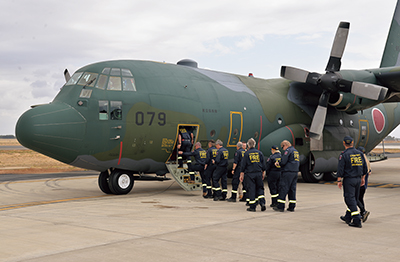 Australian Firefighters boarding the SDF aircraft (Photo: Ministry of Defense)
Australian Firefighters boarding the SDF aircraft (Photo: Ministry of Defense)Furthermore, the Japan Meteorological Agency continued providing observation images and data obtained from the meteorological satellite Himawari from November 2019 till the end of January 2020. Private Japanese corporations have also donated a total of about 5 million Australian dollars to the Government of Australia and other organizations, and contributed to the bushfire response. Japan's assistance on this occasion has left a strong mark on the friendly relations between the two countries.
B Cooperation in the Security Field
To ensure peace and prosperity of the Indo-Pacific region, Japan and Australia have continued to steadily strengthen and expand cooperation in the field of security.
To date, Foreign and Defense Ministerial Consultations have been held with Australia on eight occasions, where the two sides have held discussions on promoting bilateral security and defense cooperation, in light of the importance of cooperation between the two countries, which have both the willingness and ability to actively contribute to regional stability and prosperity. At the Japan-Australia Summit Meeting in November, the two leaders confirmed that the two countries had reached an agreement in principle on the Japan-Australia Reciprocal Access Agreement, and the two countries are accelerating the remaining necessary work toward an early signing. Additionally, Japan and Australia aim to strengthen economic security cooperation in fields such as telecommunications and critical minerals. Furthermore, Japan and Australia, as allies of the U.S., continue to further strengthen cooperation between Japan, the U.S. and Australia.
C Economic Relations
As shown by Japan and Australia spearheading the TPP11 Agreement, which entered into force in December 2018, the two countries are working closely and demonstrating leadership in promoting the regional free trade order, including the RCEP Agreement. Mainly industrial products such as automobiles are being exported from Japan to Australia, while mainly energy resources such as coal and natural gas, and agricultural products such as beef are being imported into Japan from Australia, in a mutually complementary economic relationship that has been developed steadily over the years. In recent years new cooperation efforts have been progressing, such as hydrogen-related efforts. Since the spread of COVID-19, the movement of goods, funds and people between Japan and Australia has been stagnating, the two countries are discussing ways to develop economic relations in a way that is compatible with measures to prevent the spread of COVID-19.
D Cultural and People-to-People Exchanges
There exists a foundation for affinity toward Japan in Australia cultivated over many years, as shown by the fact that approximately 400,000 people in Australia learn the Japanese language (the fourth largest group in the world), and that there are over 100 sister city relations. Until travel restrictions were enforced due to the spread of COVID-19, a variety of initiatives had been implemented in order to strengthen the foundation of Japan-Australia relations, including the promotion of mutual understanding through JENESYS, the exchange program including young people, and the “New Colombo Plan” as well as the Young Political Leaders Exchange. Both Japan and Australia will continue to work on the appropriate and steady operation of the Japan-Australia Working Holiday Program, which celebrated its 40th anniversary in 2020.
E Cooperation in the International Community
In order to make an active contribution to peace and stability in the international community, the two countries have been strengthening cooperation in wide-ranging areas. In particular, cooperation has been deepened in addressing various issues facing the Indo-Pacific region such as maritime security and nuclear and missile development by North Korea. Australia deployed the Royal Australian Navy frigate ARUNTA to undertake monitoring and surveillance activities in the adjacent ocean areas around Japan, including the East China Sea since late October, by doing so, for the fourth time since 2018, Australia has engaged in monitoring and surveillance activities against illicit maritime activities, including ship-to-ship transfers with North Korean flagged vessels, which are prohibited by UN Security Council resolutions. In addition, from late September through late October, Australia engaged in monitoring and surveillance activities for the seventh time since 2018 by aircraft, using Kadena Air Base.
(2) New Zealand
A Brief Summary and Overview
Japan and New Zealand share fundamental values, such as democracy and a market economy. The two countries have been maintaining good relations over the years. In recent years, under the “Strategic Cooperative Partnership,” the two countries have been strengthening bilateral cooperation in areas including the economy, security and defense cooperation and people-to-people exchanges, as well as cooperative relations on issues facing the region and the international community. In the general election in October, the ruling Labour Party, led by Prime Minister Jacinda Ardern, signed a cooperation agreement (non-Cabinet participation cooperation agreement) with the Greens, and a new administration was inaugurated.
B Telephone Calls with Dignitaries
Amidst the global spread of COVID-19, Japan and New Zealand, through telephone calls at the summit and foreign ministers' levels, have been conducting close exchanges of opinions on responses to COVID-19, on cooperation in the Pacific Island region and on regional affairs. In November, Prime Minister Suga held a summit telephone call with the reappointed Prime Minister Ardern. As important “Strategic Cooperative Partners” in the Indo-Pacific region sharing common values, the leaders encouraged cooperation between Japan and New Zealand on efforts to realize a “Free and Open Indo-Pacific,” on the expansion of a free and fair economic order through WTO reform and mechanisms such as the TPP11 Agreement and the RCEP Agreement, and in the field of security.
As for between foreign ministers, Foreign Minister Motegi held three telephone calls with his New Zealand counterpart Winston Peters (in April, June and September) to exchange opinions on issues such as responses to COVID-19, and they agreed that both countries would continue to cooperate, including in regional situations, under the “Strategic Cooperative Partnership” between Japan and New Zealand. Additionally, in December a foreign ministers' telephone call was held with Minister of Foreign Affairs Nanaia Mahuta, newly appointed in November, and they confirmed that they will continue to strengthen bilateral relations and to promote cooperation in the international arena.
C Economic Relations
The two countries enjoy a complementary economic relationship and have closely cooperated on the steady implementation of the TPP11 Agreement, which entered into force in December 2018, and the promotion of free trade structures including the RCEP Agreement and WTO reforms. Furthermore, in the fields of food and agriculture, the “New Zealand Hokkaido Dairy Collaboration Project” designed to improve the profitability of dairy farming in Japan was implemented from 2014 to 2018. The “New Zealand Hokkaido Sheep Collaboration Project” was launched in 2018 with the aim of vitalizing the sheep industry in Hokkaido.
D Cultural and People-to-People Exchanges
People-to-people exchanges between Japan and New Zealand, such as for youths, take place through exchange programs like JENESYS, and more than 1,100 people had participated by 2019 before travel restrictions were enforced because of the spread of COVID-19. Additionally, the 44 sister city relationships that have been cultivated between Japan and New Zealand over many years are fertile ground for people-to-people exchanges, and networking between sister cities is making progress with the aim of promoting mutual understanding among youth. Furthermore, the New Zealand Government sponsored “Game On English,” which extends support to English language education for Japanese students through rugby and boating.
E Cooperation in the International Community
The two countries are cooperating closely for the peace and stability of the international community, including the UN. In particular, against illicit maritime activities, including ship-to-ship transfers with North Korean-flagged vessels, which are prohibited by UN Security Council resolutions, in October New Zealand engaged in monitoring and surveillance activities for the third time since 2018 by aircraft, using Kadena Air Base. Furthermore, Japan and New Zealand have collaborated in regional cooperation frameworks such as the East Asia Summit (EAS), the ASEAN Regional Forum, Asia-Pacific Economic Cooperation (APEC) and the Pacific Islands Leaders Meeting (PALM). They are also cooperating over economic development in the Pacific Island region. Through these efforts, the two countries are playing a proactive role for the regional stability and development.
(3) Pacific Island Countries
A Brief Summary and Overview
Pacific Island countries and Japan are bound by the Pacific Ocean, have deep historical ties, and are important partners in such areas as cooperation in the international arena and the supply of fishery and mineral resources. They are becoming increasingly important as a cornerstone of a “Free and Open Indo-Pacific,” as they are located at the heart of the Pacific Ocean. Japan has been holding the Pacific Islands Leaders Meeting (PALM) once every three years since 1997. In February 2020, senior officials from Japan and the Pacific Island countries exchanged views in Tokyo on cooperation with the Pacific Island region as part of preparations for the Ninth Pacific Islands Leaders Meeting (PALM9) in 2021. The meeting was co-chaired by Mr. Takata Toshihisa, Ambassador for the Pacific Island Region, and Mrs. Camilla Solomon, Secretary for Foreign Affairs and Trade of Republic of Nauru, and was attended by senior officials from Pacific Island countries and regions, and there were frank exchanges of opinions on cooperation with the region. In addition, at the PALM Ministerial Interim Meeting in October 2020 that was held via teleconference, Foreign Minister Motegi co-chaired the meeting with Mr. Simon Kofe, Minister of Justice, Communications and Foreign Affairs of Tuvalu, and they followed up on the Eighth Pacific Islands Leaders Meeting (PALM8) that was held in 2018. At the Ministerial meeting, the Ministers confirmed to continue to work closely for the success of PALM9 in 2021.
B Interagency Committee for the Promotion of Cooperation with Pacific Island Countries
In 2020, the fourth, fifth and sixth meetings of the Interagency Committee for the Promotion of Cooperation with Pacific Island Countries, which is comprised of relevant governmental ministries and agencies, were held under the leadership of Special Advisor to the Prime Minister Kihara Minoru and Special Advisor to the Prime Minister Izumi Hiroto. In addition to discussing specific measures for strengthening policies toward Pacific Island countries, it was confirmed that further discussions would be held in preparation for PALM9 in 2021, in order for relevant ministries and agencies to continue to cooperate and to promote “All Japan” efforts.
C Meetings with Dignitaries.
In February 2020, Parliamentary Vice-Minister for Foreign Affairs Nakayama Norihiro led a public-private joint economic mission to Fiji, and had a meeting with Prime Minister Josaia Voreqe Bainimarama and Foreign Affairs Minister Inia Seruiratu. In July, Parliamentary Vice-Minister for Foreign Affairs Nakayama had a meeting with Mr. Ishikeli Uluinairai Mataitoga, Ambassador of Fiji to Japan, Mr. Francis Mariur Matsutaro, Ambassador of the Republic of Palau to Japan, and Dr. Tevita Suka Mangisi, Ambassador of the Kingdom of Tonga to Japan.
In August 2020, Foreign Minister Motegi visited Papua New Guinea and met with Prime Minister James Marape. At the meeting, Foreign Minister Motegi discussed Japan's support of more than 1 billion Japanese yen to strengthen health care systems, including medical supplies and equipment supplies, as well as budgetary support for early recovery of the PNG economy, which has been impacted by COVID-19. In response, Prime Minister Marape expressed his gratitude for Japan's robust support. Foreign Minister Motegi and Prime Minister Marape also signed the “Statement of Intent to Further Promote Bilateral Relations between Japan and Papua New Guinea.” In December, Parliamentary Vice-Minister for Foreign Affairs Nakanishi Satoshi held a lunch meeting at the Iikura House with the Ambassadors to Japan from Micronesia, Fiji, the Marshall Islands, Palau, Samoa and Tonga. 2020 was the 50th anniversary of the establishment of diplomatic relations between Japan and Fiji, and in October a large-scale cultural event hosted by the Embassy of Japan in Fiji was held. Parliamentary Vice-Minister for Foreign Affairs Nakanishi sent a congratulatory video message.
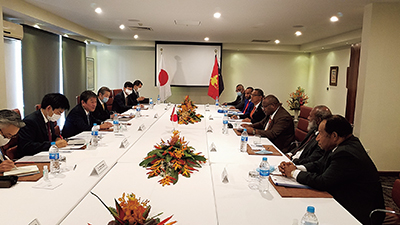 Foreign Minister Motegi meets with Prime Minister Marape (August 21, Papua New Guinea)
Foreign Minister Motegi meets with Prime Minister Marape (August 21, Papua New Guinea)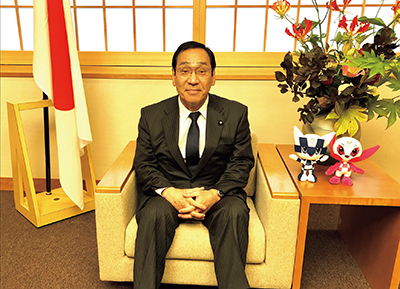 Video message from Parliamentary Vice-Minister for Foreign Affairs Nakanishi on the 50th anniversary of the establishment of diplomatic relations between Japan and Fiji (October 22, Tokyo)
Video message from Parliamentary Vice-Minister for Foreign Affairs Nakanishi on the 50th anniversary of the establishment of diplomatic relations between Japan and Fiji (October 22, Tokyo)D Cultural and People-to-People Exchanges
As part of efforts to invigorate and enhance the people-to-people exchanges announced at PALM8 in 2018, people-to-people exchanges were promoted among students through JENESYS. Furthermore, from FY2016 Japan commenced the Pacific Leaders' Educational Assistance for Development of State (Pacific-LEADS) for young government administrators of Pacific Island countries. Currently renamed the SDGs Global Leader Program, the program continues to accept young government officials from Pacific Island countries at graduate schools in Japan.

